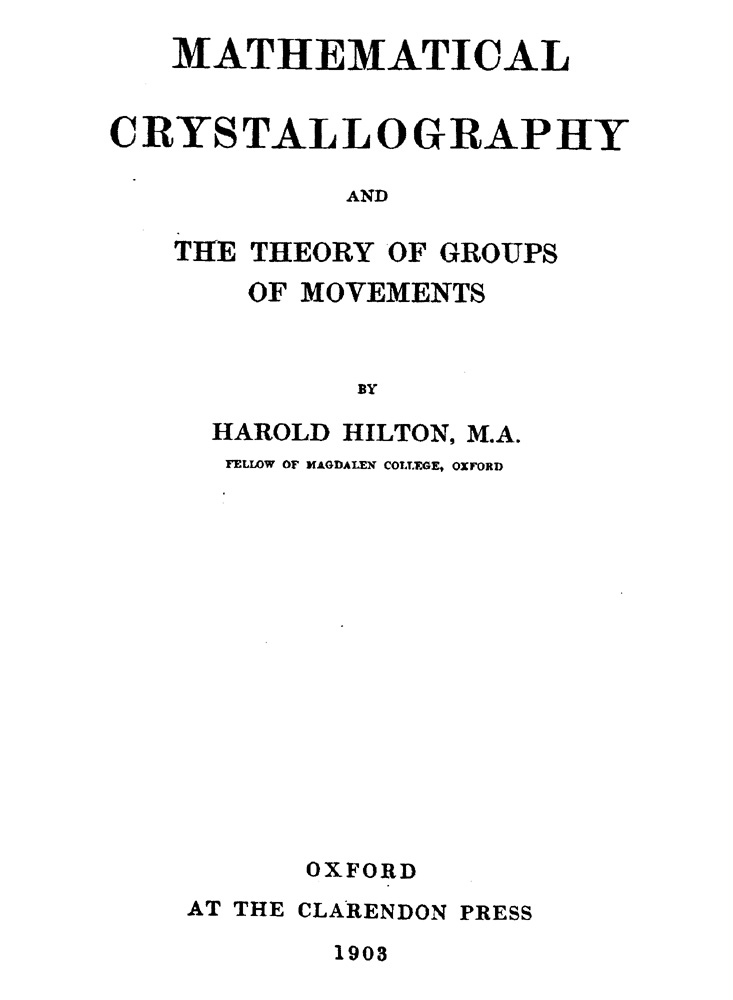HILTON, Harold.
(1876 – 1974)
From 1895 to 1898, Hilton studied at Oxford, eventually receiving his D.Sc in 1913. In 1902, he became assistant lecturer in mathematics at the University of Banger, in North Wales. In 1907, he accepted a position as assistant professor of mathematics at Bedford College, London. Finally, in 1912, Hilton became professor of math at the University of London where he remained the rest of his career. In 1939, he changed his last name to Simpson.
Biographical references: BBA: I 554, 9. • Button, Lilian G., "Harold Simpson (Formerly Hilton)," Bulletin of the London Mathematical Society, 8 (1976), no. 1, p. 91-98. • Kilmister, C.W., "The teaching of mathematics in the University of London," Bulletin of the London Mathematical Society, 18 (1986), no. 4, p. 321-337. • Poggendorff: 5, p. 540-1, 6, p. 1123 & 7b, Teil 4, p. 2015. • WBI.

1. English, 1903.
Mathematical | Crystallography | And | The Theory Of Groups | Of Movements | By | Harold Hilton, M.A. | Fellow Of Magdalen College, Oxford | Oxford | At The Clarendon Press | 1903.
8°: π6 B-R8 S2 T1; 137l.; [i]-xii, [1]-262 p., folding table, diagrams. Page size: 218 x 142 mm.
Contents: [i-ii], Title page, verso "Henry Frowde, M.A. | ..."; iii-iv, "Preface."-dated 16 April 1903.; v-xii, "Contents."; [1]-259, Text.; 260-262, "Index."
Scarce. This work collects together the results of various mathematical theories of crystallography, which had not previously been published in English. Through a careful examination of their properties, Hilton was able, with minor adjustments, to derive in a simple manner the 32 point groups and the 230 space groups. However, no practical applications of the results obtained are included. Hilton provides a full account of the geometrical theory of crystal structure as outlined by Bravais, Jordan, Sohncke, Fedorov, Schoenflies and Barlow.
Contents: I. Stereographic Projection. II. Properties Common to Symmetrical and Asymmetrical Crystals. III. Symmetry. IV. Theory of Groups. V. Finite Groups of the First Sort. VI. Finite Groups of the Second Sort. VII. Coordinates of Equivalent Points. VIII. Crystal Forms. IX. Crystallogaphic Axes and Axial Ratios. X. Dependence of Physical Properites of Crystals of Symmetry. XI. The Growth of Crystals. XII. Structure Theory. XIII. Lattices and Translations. XIV. Symmetrical Lattices. XV. Bravais Structure Theory. XVI. Properties of Geometrical Operations. XVII. Infinite Groups of Movements. XVIII. Triclinic and Monoclinic Groups. XIX. Orthorhombic Groups. XX. Tetragonal Groups. XXI. Rhombohedral Groups. XXII. Hexagonal Groups. XXIII. Regular Groups. XXIV. Space Partitioning. XXV. Crystal Molecules. XXVI. History of the Structure Theories.
Facsimile reprint: Mathematical crystallography and the theory of groups of movements. New York, Dover Publications, [1963]. [1]-xii, [1]-262 p., diagrs.
Bibliographical references: BL. • Buerger, History of Crystal Structures, 1990 [p. 109]. • Dana's 7th (Bibliography): 73. • NUC. • Senechal, History of Geometrical Crystallography, 1990 [p. 48].
.